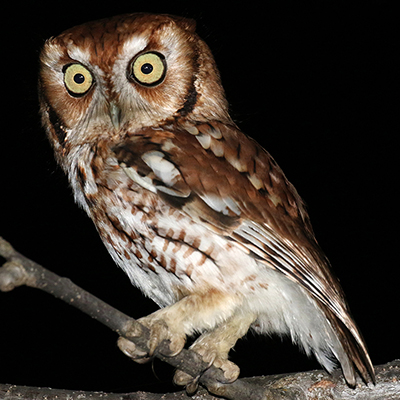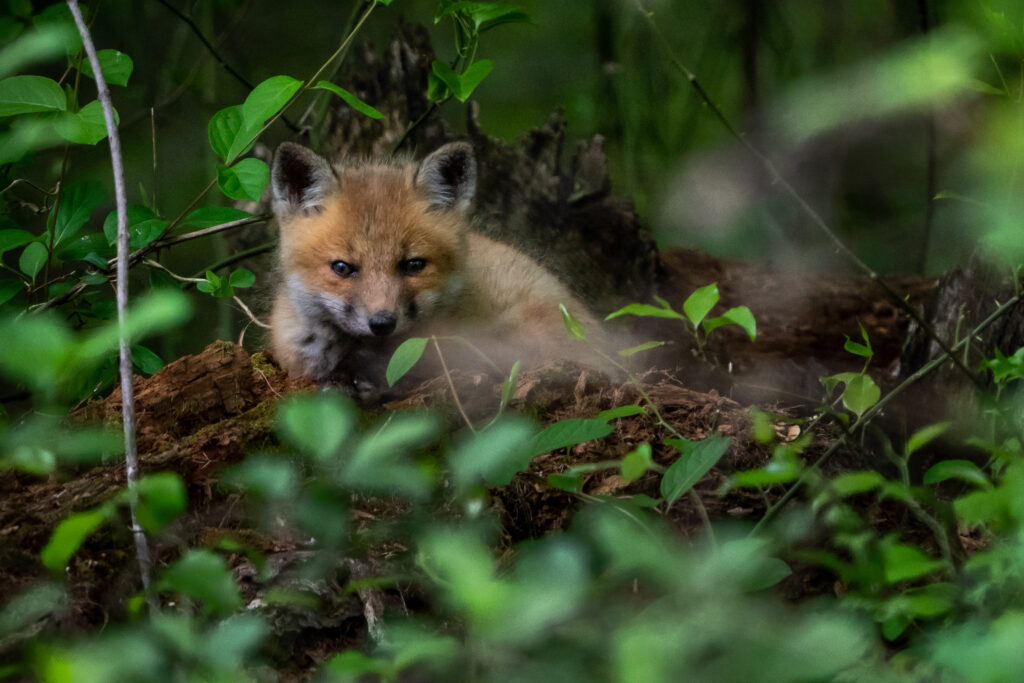By Keith Williams, Vice President of Engagement & Education
I emerged from the woods into the meadow as the last bit of orange glow slipped beneath the western horizon, past a newly cut field of corn stubble. I picked up my pace and started to hustle back to the house. I didn’t plan on being out after dark and didn’t have a head lamp. Not that I needed one – it was a bright night with a full moon coming up opposite the last of the sunset. But still, the woods here this time of year seem to hold the spirits of beings passed, and I could feel them as I walked past ancient-looking locust trees, their gnarled forms casting twisted shadows in the moonlight.

Screech Owl. CREDIT: Stephen Rannels
A shrill descending whinny in the distance drifted slowly down the wooded hill to me. I stopped moving so the crunching leaves wouldn’t get in the way of the sound. It was high pitched and wavering, and at times it sounded like a human baby crying. The hair on my arms and neck stood up, but then I realized this was just a screech owl. They make big sounds for such small birds. Screech owls are only about 8 inches long and are the smallest owls that occur here. They mainly eat a variety of small mammals, but they supplement their diet with insects, reptiles, and amphibians too. The whinny call is this screech owl’s efforts to protect his territory, and while the owls’ call inspires fear, the real fear is their disappearance. They are a common species, listed as “least concern” by the International Union for the Conservation of Nature probably because they can adapt to agricultural, suburban, and wild landscapes. However, screech owl numbers are declining in various parts of their range. The time to conserve something is when it’s common.
Once I figured out my fear response was unfounded, I continued down the trail into the dark woods. A loud, abrupt raspy yell erupted from the woods in front of me. My heart raced, and my knees got weak. I wanted to run but had nowhere to go. I didn’t want to sprint towards the sound, and I didn’t want to turn around and go further from safety, so I stopped and listened and wondered if a Chupacabra, a mythical fanged hairless beast that kills animals by sucking their blood, was about to descend on me. Or maybe this was just the Albatwitch, our region’s version of bigfoot. Either way, I froze until the noise stopped, then darted for home.
The next day I reinvestigated the area where the sound chased me from the woods. A distinct pungent musk smell overpowered the underlying earthy tones of newly fallen leaf litter. This was the smell of a fox marking his territory, and I saw one of the excavated entrances to their den a few steps later. This confirmed my suspicion that the cry last night was a fox.

A fox kit peaks out from its den in the Hellam Hills Conservation Area. CREDIT: Greg Smolin
I took advantage of the sunny fall day and kept hiking. The trail led past a series of rock outcrops, places where 600-million-year-old slabs of schist bedrock emerge from the depths of the earth due to eons of erosion. The schist was shale that was heated and compressed so that now the rock is twisted into ropy bands flecked with shimmering silver mica sparkles and white quartz veins. These are special places ecologically and spiritually. The ledges and overhangs were important habitation sites for the ancient peoples of the region, the Susquehannock and Shenks Ferry and the peoples before them. They believed that these rock outcrops are where the underworld meets the present and are connections to the ancestors. Ecologically, they are important habitat for a number of organisms, some only found in these difficult-to-access spots.
I heard a rattle and froze. I didn’t want to risk a strike. It probably wasn’t a rattlesnake – timber rattlers haven’t been heard or seen here for decades – but it was possible, and I hoped that I would see the attractive tan-and-black banded body with a big triangular head, large black vertical-slit pupils in gold-flecked irises, with a yellow rattle on the end. Rattle snakes aren’t as frightening as you might think, since they usually give us fair warning before biting. Most strikes occur on hands, the result of sticking our hands into places we can’t see (and where they probably don’t belong in the first place) or failed attempts at handling these creatures. The purpose of their venom is not to inflict it upon us, but to help them neutralize their rodent prey and protect themselves.
The noise wasn’t a rattlesnake, though. It was a black rat snake vibrating his tail against dry leaves to mimic a rattlesnake. He was shiny patent leather black with a clean white throat and belly. His skin sparkled like he just shed. His black tongue flicked and tasted the air.
The rattle mimic may not seem to make sense since there are no rattlesnakes here in Lancaster and York counties. But there used to be. We have lost rattlesnakes from this region. Some of the gaps in the rock outcrops, some of the deep holes where mystery lives, could have been den sites used by hundreds of timber rattlesnake generations over thousands of years. There is a deep time feel to these places, and maybe this is part of the reason why. Multiple generations of beings were here before me, and I hope we can bring them back.
As I pondered the snake, something that sounded 10 feet tall and a thousand pounds heavy crashed down the hill through the leaves accumulated in the spaces between the bedrock slabs. But I couldn’t see anything. Was this a ghost hurtling towards me? A spirit of the ancestors emerging from the underworld?
It got louder and the creature got bigger until, just 5 feet from me, a grey squirrel jumped from the ground onto a tree. Squirrels always sound much larger than they actually are in dried leaves. I wonder if that squirrel, and the noise she made, was the embodiment of an Allegheny woodrat, another creature who once called this region home.
Allegheny woodrats are a kind of packrat that used to occur here. They are considered “near threatened” by the International Union for the Conservation of Nature. Allegheny woodrat loss may be related to the loss of American chestnut trees. Once dominant on dry rocky ridges, American chestnuts produced large quantities of nuts that served as the Allegheny woodrats’ food, along with acorns from oaks. As we eliminate fire from our forests, maples are favored over oaks, so oaks too are declining. And I wonder if part of the timber rattlesnake decline is related to the woodrat decline, which is related to the chestnut and oak decline. It is indeed all hitched together – past hitched to present which dictates future.
This is the real fear. The ghosts of creatures past, beings lost, remind us of what is now missing from our landscape. Species loss leads to biodiversity reduction, which makes ecosystems more fragile and susceptible to collapse. The ghosts of species past are here: the spirits of timber rattlers and woodrats and chestnuts, the Susquehannocks and Shenks Ferry people and others.
I think the Native people had it right: these outcrops are connections to beings of the past. And maybe they are portals into the future, as well. If we do not act, who else will we lose from our community besides the rattlesnake, and woodrat? Or maybe the better, more hopeful question is: who will we welcome back, who will we save from disappearing, as we continue to protect and restore this landscape so that it can thrive?
